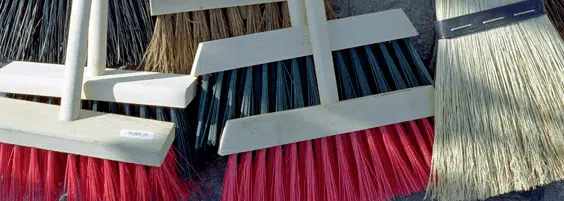It doesn’t matter whether you’re tending to a tiny balcony or a ten-acre plot. You need a brush.
You can do away with a lot of tools and still manage.
Brooms, on the other hand, are hard to do without. And I don’t mean for achieving the intrinsically satisfying look of a swept patio or greenhouse floor.
If you’re doing any kind of gardening work – potting up, pruning, harvesting – then you’re going to make a mess.
In this post, I’ve taken a look at some of the best brooms on the market. There won’t be any floppy handles or unattached heads with these brooms.
Let’s dive in.
The Short Version: Best Garden Brooms/Brushes
Click here to jump to our in-depth reviews of the best outdoor brooms.
- 18″ Stiff Yard Brush (£) (Top Pick)
- Eyliden 24″ Broom (£££) (Best Bigger Brush)
- GLOYY Angular Brush (££) (Best Brush for Smaller Outdoor Spaces)
- Asian Mini-Broom (£) (Best for Odd Jobs)
- Corn Straw Broom (£) (Best for Aesthetics)
Guide: Parts of a Broom
There are three essential parts to any broom: the handle, head and bristles.
On the heavy-use end of the spectrum, you have piassava brooms, so-called because the bristles are made from the fronds of the piassava palm. They tend to have a wide and heavy wooden head.
Nowadays, bristles are mostly made from synthetic fibres, particularly nylon. That said, you can still find traditional models.
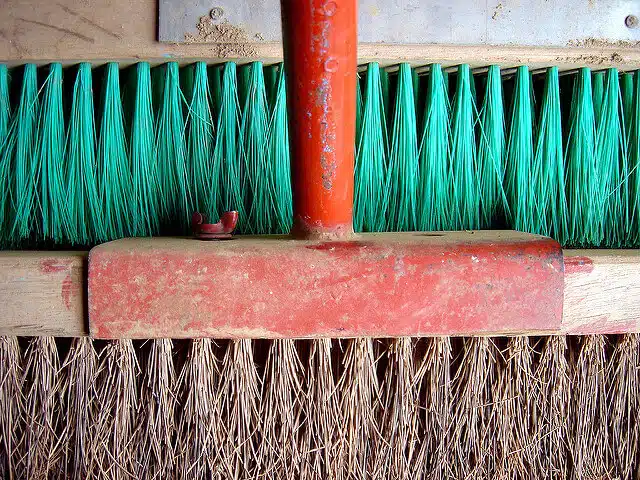
One of the main problems with old-fashioned brooms is that the handle eventually comes loose from the head. You can now buy models with anti-rotation locking systems, which overcomes this problem, so that’s something to be aware of.
Good Brooms and Bad Brooms
Generally speaking, the wide-head brooms (whether made from nylon or piassava) are less than ideal for gardening purposes.
They’re too big to get into crannies and it’s difficult to put any weight on them.
At the other end of the spectrum, you have soft-haired indoor brooms. Like the wide-head types, these are largely unsuitable for outdoor use and should be avoided.
It’s also worth mentioning corn (or “sorghum”) brooms. They have a rustic look about them and many people love the aesthetics. While they can be good for larger debris, they won’t pick up smaller pieces.
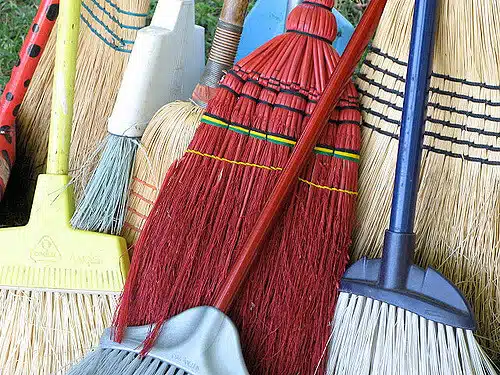
Features to Look for in a Good Broom
The best outdoor brooms have medium-sized heads and short(ish) fibres.
This design is good for picking up all sorts of garden materials and nimble enough to manoeuvre into hard-to-reach places.
Here are the main features to look for when picking a broom:
- Strong bristles – Though both work well, nylon or synthetic bristles are usually more hard-wearing than those made from natural fibres. Just make sure that they’re stiff.
- Screw-in handle – Look for an anti-rotation locking device where possible. Always go for a screw-in handle. Handles that are slotted in (and usually glued) invariably come loose and are a nightmare to put back together.
- Width – As I mentioned, the really long-headed brooms are hard to weigh down. Heads above 18 inches wide are, in my opinion, best avoided unless you’ve got a really big space to look after.
Best Outdoor Brooms: Top Picks
***Full Disclosure – Where appropriate, I’ve linked product images to commercial sites and Amazon (see Amazon Disclosure). If you buy from these sites, I earn a small affiliate fee, which helps me keep Urban Turnip going.***
1. 18″ Stiff Yard Brush
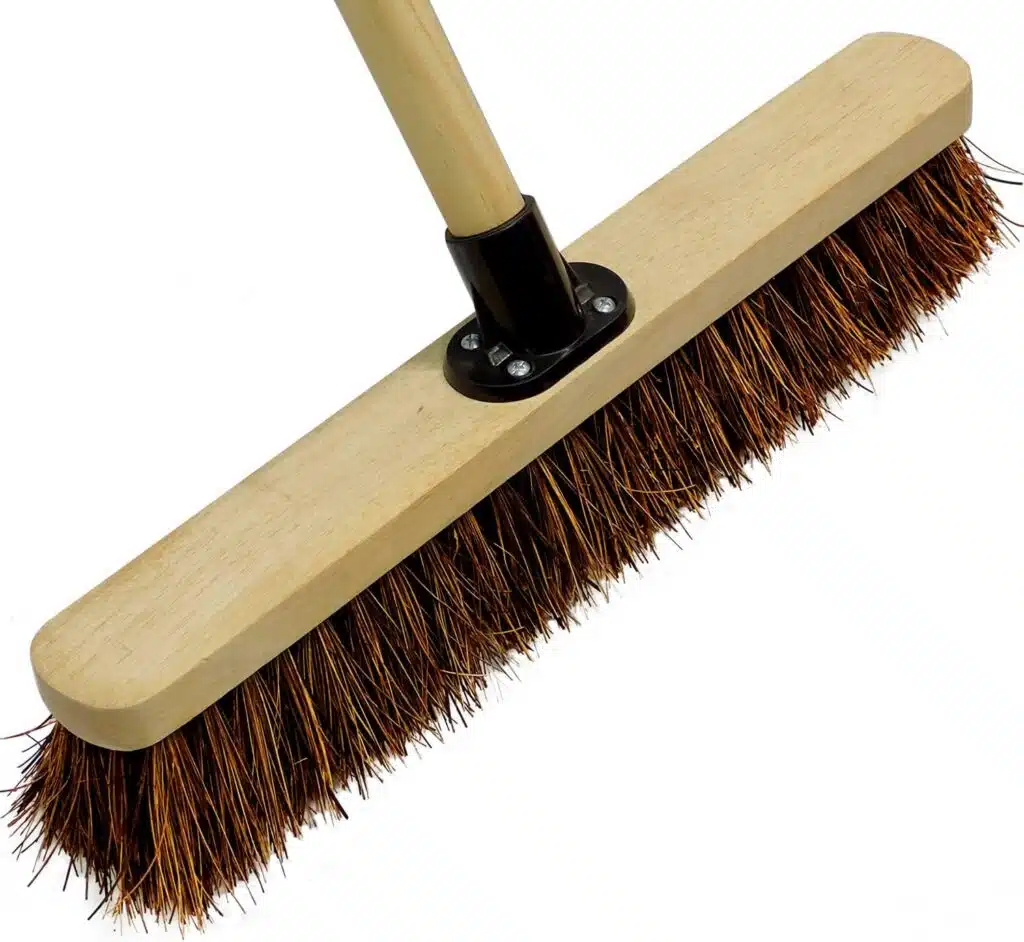
If you’re looking for a sturdy, durable broom in a fairly standard design then this 18-inch model from EDS, a brand that operates exclusively through Amazon, is perfect for you. You won’t do better on the price, either.
The handle, which is a fairly standard 120cm, is very easy to attach to the black, screwed-in bracket (which seems sturdy enough). There are a few complaints about it coming loose but, in my experience, this is an inescapable problem with all types of brooms. Superglue or a nail will solve the problem if it arises.
The brush itself is made from unflagged Bassine bristles. Unflagged means the edges aren’t frayed, making it suitable for sweeping larger items (frayed edges are designed to pick up small pieces of debris and require softer bristles). Bassine is a type of palm tree that is commonly used to make broom bristles.
At 18 inches, I think the head size of this broom is ideal, allowing you to apply pressure while still covering a good area.
2. Eyliden 24″ Broom
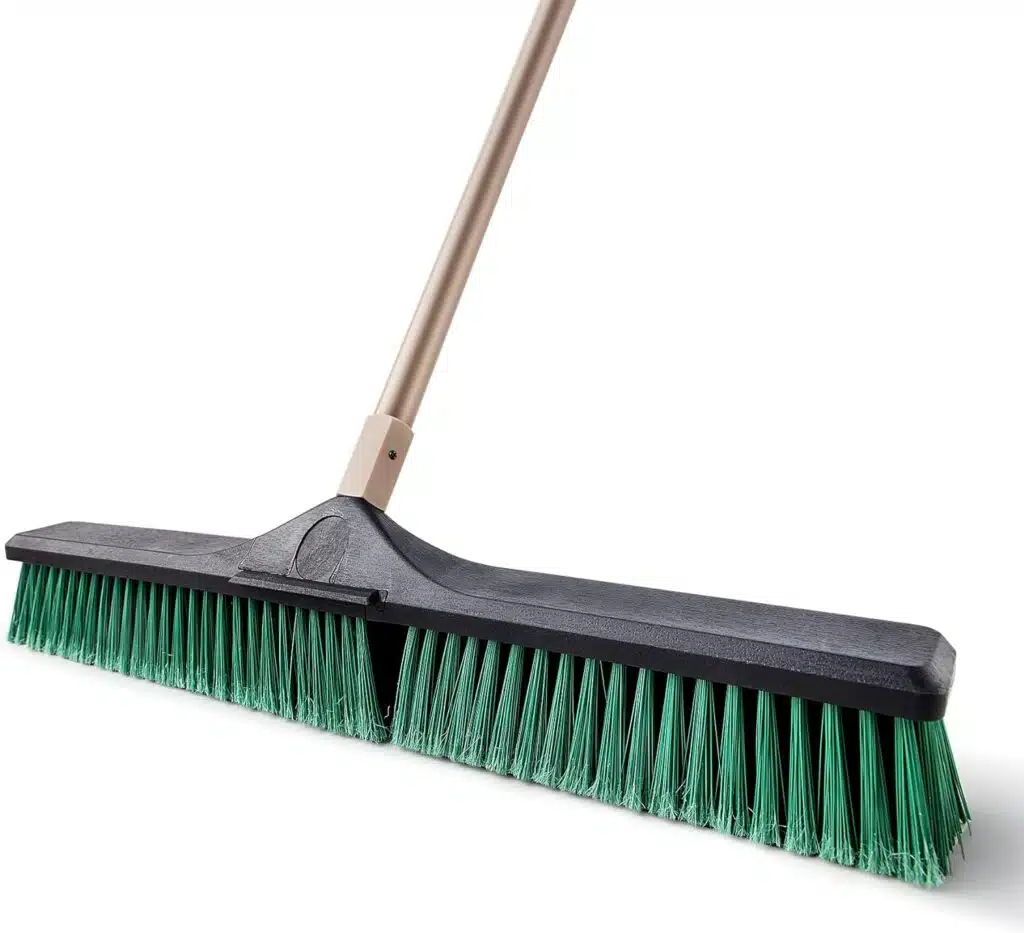
The trouble with big “industrial level” brooms is that they’re not very nimble and it can be hard to apply pressure on them. If you do need to cover a bigger space, however, this 24-inch broom from Eyliden overcomes many of these issues. It’s easily the best-quality larger brush I’ve come across.
The handle has a screw-in threaded connection where it meets the head. So you won’t encounter the issue of the handle coming out. It can also be deconstructed (the head splits into two pieces) for storage.
The handle pole itself is made from steel (so is stronger than wood) and is extendable, so can be adjusted based on your height. The handle sits at a 45-degree angle on the head, which allows you to apply more force and gives a generally sturdier feel.
Finally, the bristles are of two sorts. An outer ring of softer bristles, which are useful for catching small debris, and an inner section of harder bristles, perfect for bigger, stronger dirt and detritus.
3. GLOYY Angle Broom
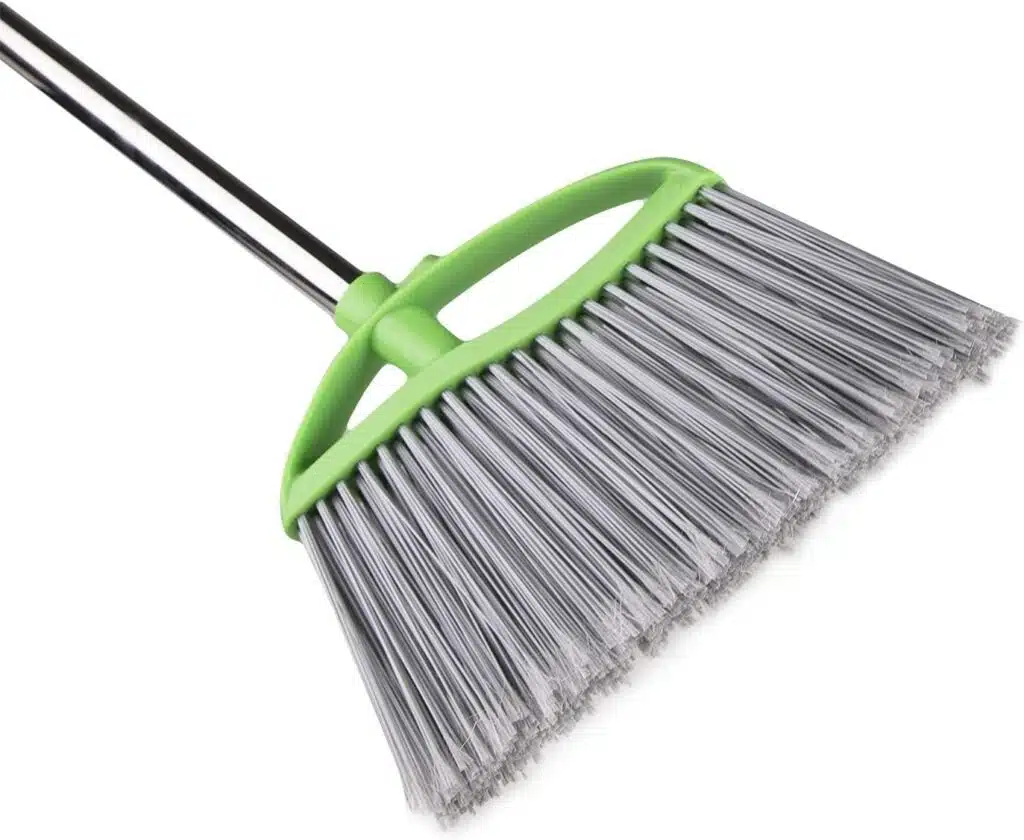
The tilted design of the GLOYY angle broom makes it easier to get into corners. If you have a patio or balcony with lots of tight spaces and crevices between pots, then this broom is ideal. It’s also good to have along with a bigger broom for tidying up small pieces of debris.
It has stiff synthetic bristles, something that it’s important to look out for when picking an angular brush for outdoor use. The indoor models have much softer bristles and aren’t suitable for gardens.
The handle is also extendable (59 inches max), which makes a nice change from waist-high models.
4. “Asian” Mini-Broom
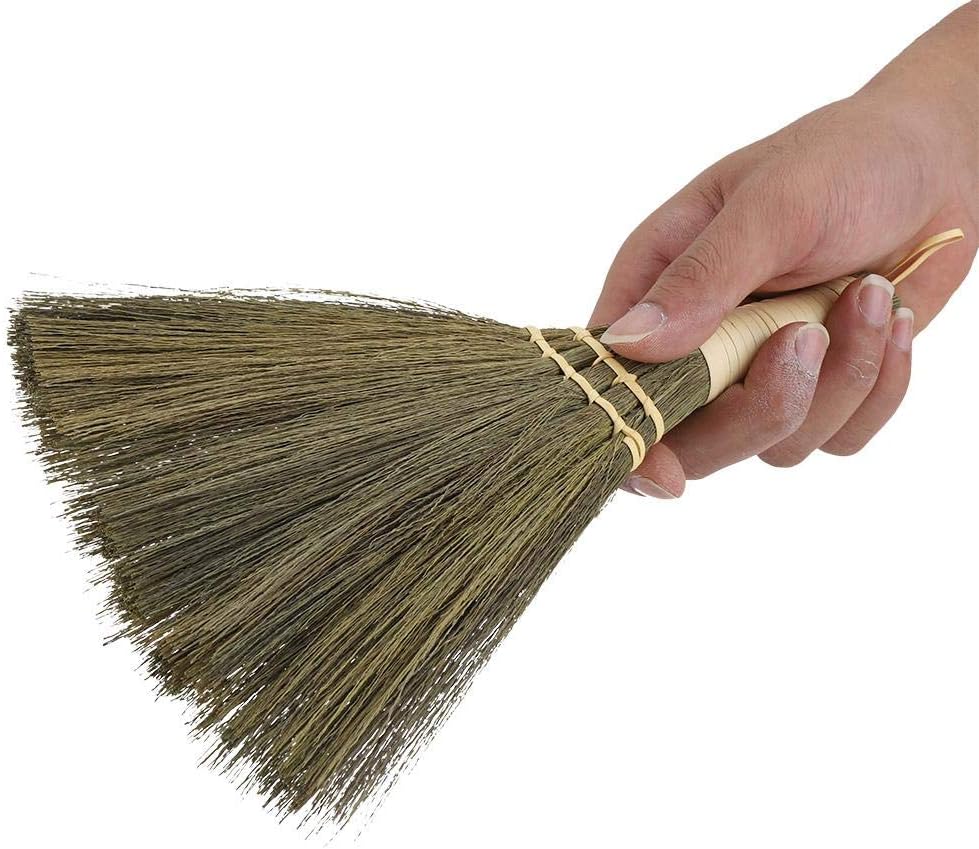
This Thai-style broom is ideal for having to hand for smaller jobs. Think sweeping down your table after repotting,
I’m perhaps a touch biased (I travelled to Thailand and developed a slightly abnormal affinity to these brooms), but they are surprisingly suitable for patios and balconies.
The bristles are stiff (some kind of tough grass), and they’re not too big. This broom is also suitable for indoor use.
I’ve found it’s easy to knock dirt and debris off the bristles and I’ve never had an issue cleaning them. Just a few taps over the side of the balcony.
The other great thing about these brooms is that they’re inexpensive. The occasional bristle will come away, but I’ve never found this too much of a problem.
5. Corn Straw Broom

If you’re looking for a “corn broom” then this option from Elliott is inexpensive, durable and eco-friendly.
The fibres are made from corn straw and tightly sealed around the base of the handle in a traditional design. They’re stiff and, as a result, excellent for catching medium and large pieces of debris.
It also really looks the part. There’s no plastic (it’s all wood) and it’s weatherproof. You can leave it propped up without having to worry about the rain and heat. Because of the strength of the bristles, it’s also suitable for sweeping away snow.
Let us know your thoughts! Leave a comment for me below!
What are your thoughts? Have you tried any of the brooms in this list? Do you have your own suggestions? Leave a comment below and let me know!
Image credits: Brooms by Angie Harms; Quidditch by Rootytootoot; Brooms by yukari abe.
